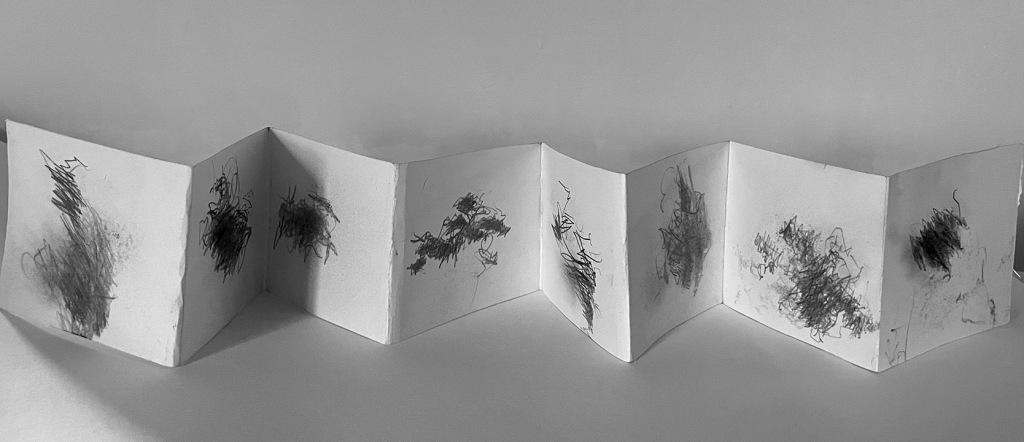
Lundy Walking – Jane Sharkey
Exploring Phenomenological Drawing: A Walk with William Anastasi
Whilst researching Artistic Walking pracrtive, I found myself drawn to the work of William Anastasi, particularly his intriguing pocket drawing method. Anastasi’s approach, as mentioned in Mueller (2023), offers a unique way of engaging and connecting with landscape.
Embarking on my own walking journey, I embraced Anastasi’s methodology Armed with a soft pencil and sheets of paper folded into a concertina, I set out to record my movements with the natural rhythms of the landscape.
Breaking down my journey into sections, I followed Anastasi’s lead, marking each leg of my exploration with a new page. From the start I headed out of the village to the west paths leading to Jenny’s Cove and then headed inland to Pondsbury, venturing onto the upper East Path back to the village. Whilst I walked I allowed my hand, nestled loosely in my pocket, to move across the paper, translating the undulating contours of the terrain into tangible marks.
Anastasi aptly describes this process as ‘phenomenological drawing’ (2019), where although the mind remains attuned to the sensory richness of the environment the hand autonomously responds to the undulation and tred. As I traversed the landscape, my senses were heightened, and my awareness expanded beyond the visual to encompass the subtle shifts in texture, elevation, and atmosphere.
What struck me most was the symbiotic relationship between my body’s proprioceptive awareness and the act of mark making. Drawing upon Gooley’s insights into proprioception (2014, p. 49), I became acutely attuned to the proprioceptive feedback of my limbs as they navigated the landscape. With each step, my hips and legs relayed the contours of the terrain to my hand, resulting in movement and mark-making.
I feel this journey into phenomenological drawing not only deepened my connection to the landscape but also broadened my understanding of the artistic process. By relinquishing control to the interplay of body and environment, I uncovered a newfound appreciation for the intricate choreography of perception and creation.
In essence, Anastasi’s pocket drawing method served as a conduit for experiencing the landscape in its entirety — not merely as a visual spectacle but as a multisensory experience of proprioception, movement, and artistic expression.
References
Gooley, T., and The School of Life, (2014). How to Connect with Nature. Pan Macmillan.
Mueller, E., (2023). Walking as Artistic Practice. State University of New York Press.
NewArtTV, (2019). William Anastasi. Youtube. [Online]. Available at https://www.youtube.com/watch?v=nvJQliLDr1s. [Accessed on 24/02/2024]
2 responses to “Exploring Phenomenological Drawing”
Coincidentally I’ve been reading about wild drawing recently. There are so many interesting ways to try to capture the quiddity of a place in nature.
LikeLiked by 1 person
Would be great to do a Colab
LikeLike